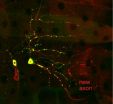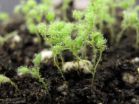(Press-News.org) Norwich scientists are on the trail of some of the most economically damaging organisms that infect crops worldwide. Their latest targets are the parasitic water fungus that causes powdery mildew and the water molds that cause late blight in potatoes and tomatoes and downy mildew in cruciferous vegetables and other crops.
"We have been studying the late blight pathogen for a while," said Professor Sophien Kamoun, head of the Sainsbury Laboratory on the Norwich Research Park. "In separate research we are trialling plant genes that mediate blight resistance, while in this latest study we have learnt more about how the pathogen itself evolved and which genes we should focus on to tackle it."
The scientists compared the genome of the potato blight pathogen to the genomes of four sister species that infect plants as diverse as morning glory and the ornamental four o-clock. These closely related pathogens are from Mexico, the centre of origin of the late blight pathogen.
The analysis showed that some sections of the genome are slow to evolve and are highly similar between the sister species. Other sections are more dynamic and allow the pathogen to quickly jump hosts to infect and adapt to new plant species.
"Our aim is to develop resistance to genes from the stable, slowly-evolving region of the pathogen's genome," said Professor Kamoun.
"This should be more disruptive to the pathogen's ability to evolve new races."
Published in the same edition of the journal Science are two studies focusing on mildews. Like the late blight pathogen, the parasite that causes downy mildew is a kind of water mold or oomycete. The oomycetes are fungal-like organisms that have evolved from marine algae. Downy mildew causes yellow patches and fuzzy white mould on the leaves of many crops including crucifers, maize, grapes and lettuce. Powdery mildew is a fungal disease of barley that is most damaging in cool, wet climates.
"A major focus of our research is sustainable agriculture," said John Innes Centre director Professor Dale Sanders.
"We need to help breeders and farmers generate good quality food and other agricultural products in an environmentally sustainable way. One way of doing so will be to develop crops that are resistant to pathogens and pests. Such crops will reduce the need to spray pesticides and fungicides and they will give better yields, as less will be lost to disease."
The genomes of the parasites have been sequenced in separate research collaborations, one involving John Innes Centre scientists and the other The Sainsbury Laboratory. The genomes were compared with those of closely related species.
Analysis revealed that the parasites have discarded many genes. They have become specialised to live solely on their plant host and have dispensed with the genes that would be needed to survive elsewhere. Instead they have focussed on genes that help them stealthily take control of host cells. The genome sequences reveal large numbers of effector proteins, the molecules that invade plant cells to suppress plant immunity.
INFORMATION:
Gene hunters tackle crop diseases
2010-12-10
ELSE PRESS RELEASES FROM THIS DATE:
Key protein discovered that allows nerve cells to repair themselves
2010-12-10
A team of scientists led by Melissa Rolls, an assistant professor of biochemistry and molecular biology at Penn State University, has peered inside neurons to discover an unexpected process that is required for regeneration after severe neuron injury. The process was discovered during Rolls's studies aimed at deciphering the inner workings of dendrites -- the part of the neuron that receives information from other cells and from the outside world. The research will be published in the print edition of the scientific journal Current Biology on 21 December 2010.
"We already ...
Thought for food: New CMU research shows imagining food consumption reduces actual consumption
2010-12-10
PITTSBURGH—If you're looking to lose weight, it's okay to think about eating your favorite candy bar. In fact, go ahead and imagine devouring every last bite — all in the name of your diet.
A new study by researchers at Carnegie Mellon University, published in Science, shows that when you imagine eating a certain food, it reduces your actual consumption of that food. This landmark discovery changes the decades-old assumption that thinking about something desirable increases cravings for it and its consumption.
Drawing on research that shows that perception and mental ...
Massive gene loss linked to pathogen's stealthy plant-dependent lifestyle
2010-12-10
An international team of scientists, which includes researchers from Virginia Tech, has cracked the genetic code of a plant pathogen that causes downy mildew disease. Downy mildews are a widespread class of destructive diseases that cause major losses to crops as diverse as maize, grapes, and lettuce. The paper describing the genome sequence of the downy mildew pathogen Hyaloperonospora arabidopsidis, which attacks the widely studied model plant Arabidopsis thaliana, is the cover story of this week's edition of the journal Science.
In the paper, the sequence of H. arabidopsidis ...
Cutting dietary phosphate doesn't save dialysis patients' lives
2010-12-10
Doctors often ask kidney disease patients on dialysis to limit the amount of phosphate they consume in their diets, but this does not help prolong their lives, according to a study appearing in an upcoming issue of the Clinical Journal of the American Society Nephrology (CJASN). The results even suggest that prescribing low phosphate diets may increase dialysis patients' risk of premature death.
Blood phosphate levels are often high in patients with kidney disease, and dialysis treatments cannot effectively remove all of the dietary phosphate that a person normally consumes. ...
Duchenne muscular dystrophy is ultimately a stem cell disease
2010-12-10
Researchers have long known that the devastating disease called Duchenne muscular dystrophy (DMD) is caused by a single mutation in a gene called dystrophin. The protein encoded by that gene is critical for the integrity of muscle; without it, they are easily damaged. But new findings in mice reported online in the journal Cell on December 9th by researchers at Stanford suggest that disease symptoms, including progressive muscle weakening leading to respiratory failure, only set in when skeletal muscle stem cells can no longer keep up with the needed repairs.
"This is ...
New mouse model for duchenne muscular dystrophy implicates stem cells, Stanford researchers say
2010-12-10
STANFORD, Calif. — For years, scientists have tried to understand why children with Duchenne muscular dystrophy experience severe muscle wasting and eventual death. After all, laboratory mice with the same mutation that causes the disease in humans display only a slight weakness. Now research by scientists at the Stanford University School of Medicine, and a new animal model of the disease they developed, points a finger squarely at the inability of human muscle stem cells to keep up with the ongoing damage caused by the disorder.
"Patients with muscular dystrophy experience ...
Adapting agriculture to climate change: New global search to save endangered crop wild relatives
2010-12-10
ROME (10 December 2010)—The Global Crop Diversity Trust today announced a major global search to systematically find, gather, catalogue, use, and save the wild relatives of wheat, rice, beans, potato, barley, lentils, chickpea, and other essential food crops, in order to help protect global food supplies against the imminent threat of climate change, and strengthen future food security.
The initiative, led by the Global Crop Diversity Trust, working in partnership with national agricultural research institutes, Royal Botanic Gardens, Kew, and the Consultative Group ...
Early study analysis suggests exemestane reduces breast density in high risk postmenopausal women
2010-12-10
San Antonio, Tex. -- A drug that shows promise for preventing breast cancer in postmenopausal women with an increased risk of developing the disease, appears to reduce mammographic breast density in the same group of women. Having dense breast tissue on mammogram is believed to be one of the strongest predictors of breast cancer. The preliminary analysis from the small, phase II study was presented today at the 33rd Annual CTRC-AACR San Antonio Breast Cancer Symposium in Texas.
The ongoing study at Georgetown Lombardi Comprehensive Cancer Center and the Center for Cancer ...
Charging makes nano-sized electrodes swell, elongate and spiral
2010-12-10
RICHLAND, Wash. -- New high resolution images of electrode wires made from materials used in rechargeable lithium ion batteries shows them contorting as they become charged with electricity. The thin, nano-sized wires writhe and fatten as lithium ions flow in during charging, according to a paper in this week's issue of the journal Science. The work suggests how rechargeable batteries eventually give out and might offer insights for building better batteries.
Battery developers know that recharging and using lithium batteries over and over damages the electrode materials, ...
Black holes and warped space: New UK telescope shows off first
2010-12-10
Spearheaded by the University of Manchester's Jodrell Bank Observatory and funded by the Science and Technology Facilities Council, the e-MERLIN telescope will allow astronomers to address key questions relating to the origin and evolution of galaxies, stars and planets.
To demonstrate its capabilities, University of Manchester astronomers turned the new telescope array toward the "Double Quasar". This enigmatic object, first discovered by Jodrell Bank, is a famous example of Einstein's theory of gravity in action.
The new image shows how the light from a quasar billions ...


